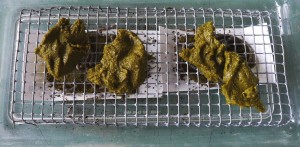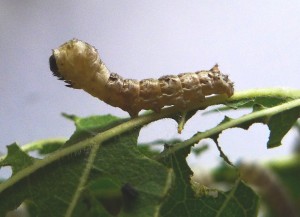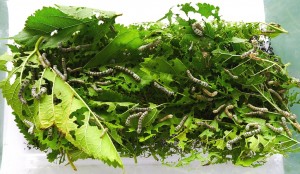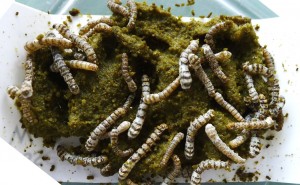The silkworms are growing well and some have now entered the third instar.
It is now clear that the ones feeding on mulberry leaves are growing faster; many of these are now in the third instar, whereas few of those feeding on artificial diet are. The largest larvae are now almost 20 mm long, and will soon really start to feed and put on weight.
It is interesting to watch the behaviour of the larvae on the two foodstuffs. Those feeding on mulberry leaves are quite lively, wandering around over the leaves and each other and rearing up when the lid of the container is removed. By contrast, those on the artificial diet are quite still with their heads down, feeding away.
Now, to grow fast and produce large caterpillars with lots of silk, we don’t want very mobile caterpillars, wasting their energy and time on silly things such as moving; they should just be feeding – yet these are the ones growing fastest.
I was a bit concerned that although the temperature at 24-26C is OK, the humidity might be a little low in the rearing room. Low humidity can impede moulting, with the larva dying in the process. Thus, I have put some trays of water in the room, and the worms seem to be managing to moult to the third instar.
The caterpillars feeding on mulberry are quite well behaved, they soon move onto new food added on top of the old, and then the old food can be removed and the rearing container cleaned. In contrast the artificial diet presents some problems. The larvae seem reluctant to leave it for days, even when it has dried out and is covered with webbing, and I don’t want to move any more than absolutely necessary by hand, in case I damage the larvae. I have tried adding new food on strips of margarine tub (food-grade plastic and thus can be sterilised), which works quite well, and can then be moved with the larvae to a clean container. I have also tried placing the new food on a wire mesh above the old.

Placing new artificial diet on wire mesh over the silkworms in the hope that they will move to the new food has so far proved unsuccessful
Unfortunately, the larvae are too small to be able to move onto this, and so I had to help them.
You might also like to have a look at this posting on another University of Reading blog where I talk about the mulberry species that we are feeding to the silkworms.



